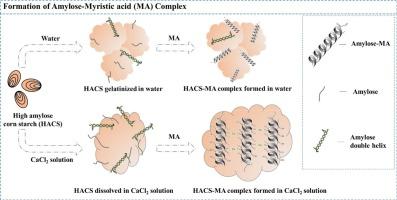高直链玉米淀粉与肉豆蔻酸在CaCl2水溶液中的络合机制:Ca2+配位结构的作用
IF 12.5
1区 化学
Q1 CHEMISTRY, APPLIED
引用次数: 0
摘要
淀粉-脂复合物在功能食品、食品添加剂和食品包装材料等方面具有潜在的应用前景。高直链玉米淀粉(HACS)是一种很有前途的淀粉-脂络合原料。为了克服常压下HACS糊化不良的问题,我们利用CaCl2水溶液溶解HACS的能力,从而简化了HACS-脂质复合物的制备。以肉豆蔻酸(MA)为例,在去离子水中制备的HACS-MA (H-MA)配合物的络合指数(CI)为36.15%,而在CaCl2水溶液中制备的HACS-MA (H-MA)络合指数(CI)为89.03%。化学基团分析和热表征表明,Ca2+离子不仅通过金属偶极相互作用促进HACS溶解,而且与淀粉的羟基氧原子结合,形成促进单螺旋排列的配位结构。本研究阐明了CaCl2水溶液中淀粉-脂络合的机理,并明确了Ca2+离子在络合中的作用。本文章由计算机程序翻译,如有差异,请以英文原文为准。

Complexation mechanism of high-amylose corn starch and myristic acid in CaCl2 aqueous solution: The role of Ca2+ coordination structure
Starch-lipid complexes have potential applications in functional foods, food additives, and food packaging materials. High-amylose corn starch (HACS) is a promising raw material for starch-lipid complexation. To overcome the poor gelatinization of HACS under atmospheric pressure, we leveraged the capacity of a CaCl2 aqueous solution to dissolve HACS, thereby streamlining the preparation of HACS-lipid complexes. Taking myristic acid (MA) as example, the HACS-MA (H-MA) complex prepared in deionized water exhibited a complexing index (CI) of 36.15 %, whereas that prepared in CaCl2 aqueous solution achieved a significantly higher CI of 89.03 %. Chemical group analysis and thermal characterization indicated that Ca2+ ions not only enhanced HACS dissolution through metal-dipole interactions but also bound to the hydroxyl oxygen atoms of starch, forming a coordination structure that promoted a single helical arrangement. This study clarifies the mechanism of starch-lipid complexation in CaCl2 aqueous solution and defines the role of Ca2+ ions in the complexes.
求助全文
通过发布文献求助,成功后即可免费获取论文全文。
去求助
来源期刊

Carbohydrate Polymers
化学-高分子科学
CiteScore
22.40
自引率
8.00%
发文量
1286
审稿时长
47 days
期刊介绍:
Carbohydrate Polymers stands as a prominent journal in the glycoscience field, dedicated to exploring and harnessing the potential of polysaccharides with applications spanning bioenergy, bioplastics, biomaterials, biorefining, chemistry, drug delivery, food, health, nanotechnology, packaging, paper, pharmaceuticals, medicine, oil recovery, textiles, tissue engineering, wood, and various aspects of glycoscience.
The journal emphasizes the central role of well-characterized carbohydrate polymers, highlighting their significance as the primary focus rather than a peripheral topic. Each paper must prominently feature at least one named carbohydrate polymer, evident in both citation and title, with a commitment to innovative research that advances scientific knowledge.
 求助内容:
求助内容: 应助结果提醒方式:
应助结果提醒方式:


